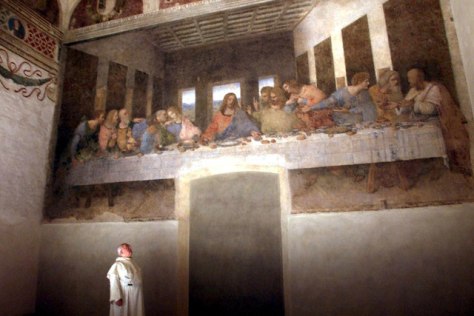Short answer: Maybe?
Long answer: I was talking to a friend last night and we got to talking about the Jewish Halacha of reclining (Hasava - הסבה in Hebrew) during the Passover Seder, when suddenly I realized: Wait a minute, The Last Supper took place on Seder night, and in da Vinci's famous painting, they aren't reclining!
A little background: Reclining on low beds was the way rich people both in the Middle East and in the Greco-Roman cultures used to eat. It was so heavily identified with prominence and elitism that this became a Halacha in Judaism for Seder night, the first night of Passover. There's a Mishna that says that even a poor man of Israel shouldn't eat until he is reclining (because reclining shows that you're a free person).
As is well-known, Jesus and his disciples were Jewish at the time of his death. The last supper was his last meal before the crucifixion and thought to be (to my knowledge), the Passover feast of the first night of Passover. While it's true that the Passover meal then was the Temple-era version and different from what we have today (which is partially in remembrance of the Temple-era version), but the concept of appearing and feeling like a free, important person during Passover was always a theme. The Mishna I mentioned above could've been written during or around Jesus's time (The entire Mishna was completed around the year 200 CE if I remember correctly). In fact, there's a well-known story in the Talmud about five famous rabbis reclining in Bnei Brak on Passover night. This was around the time of the Bar-Kochva Revolt, only 100 years after Jesus's time. With all this being said, I think it's fair to assume that even during Jesus's time it was traditional to recline during the Passover meal.
Yet Leonardo da Vinci - and other artists as can be viewed here: Last Supper - Wikipedia - decided to depict those early "Jewish-Christians" not reclining during the meal, but sitting on regular chairs with a high table and eating like they did during the Renaissance and till today. LDV was a smart person, but I don't know if he ever had any contact with Jews in his life, so it's very possible that he had no idea that this is how Jews eat on Seder night. Another possibility is that he was aware of this but wanted to be able to depict everyone's faces, maybe also some action in the scene. With everyone reclining on low beds in a circle around a table, it would've been hard to draw everyone and show anything exciting going on.
Just my two-cents on the subject.
Long answer: I was talking to a friend last night and we got to talking about the Jewish Halacha of reclining (Hasava - הסבה in Hebrew) during the Passover Seder, when suddenly I realized: Wait a minute, The Last Supper took place on Seder night, and in da Vinci's famous painting, they aren't reclining!
A little background: Reclining on low beds was the way rich people both in the Middle East and in the Greco-Roman cultures used to eat. It was so heavily identified with prominence and elitism that this became a Halacha in Judaism for Seder night, the first night of Passover. There's a Mishna that says that even a poor man of Israel shouldn't eat until he is reclining (because reclining shows that you're a free person).
As is well-known, Jesus and his disciples were Jewish at the time of his death. The last supper was his last meal before the crucifixion and thought to be (to my knowledge), the Passover feast of the first night of Passover. While it's true that the Passover meal then was the Temple-era version and different from what we have today (which is partially in remembrance of the Temple-era version), but the concept of appearing and feeling like a free, important person during Passover was always a theme. The Mishna I mentioned above could've been written during or around Jesus's time (The entire Mishna was completed around the year 200 CE if I remember correctly). In fact, there's a well-known story in the Talmud about five famous rabbis reclining in Bnei Brak on Passover night. This was around the time of the Bar-Kochva Revolt, only 100 years after Jesus's time. With all this being said, I think it's fair to assume that even during Jesus's time it was traditional to recline during the Passover meal.
Yet Leonardo da Vinci - and other artists as can be viewed here: Last Supper - Wikipedia - decided to depict those early "Jewish-Christians" not reclining during the meal, but sitting on regular chairs with a high table and eating like they did during the Renaissance and till today. LDV was a smart person, but I don't know if he ever had any contact with Jews in his life, so it's very possible that he had no idea that this is how Jews eat on Seder night. Another possibility is that he was aware of this but wanted to be able to depict everyone's faces, maybe also some action in the scene. With everyone reclining on low beds in a circle around a table, it would've been hard to draw everyone and show anything exciting going on.
Just my two-cents on the subject.

